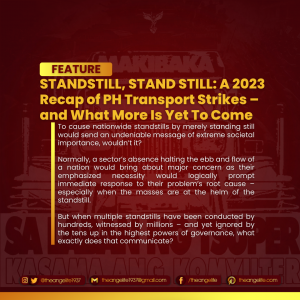
 To cause nationwide standstills by merely standing still would send an undeniable message of extreme societal importance, wouldn’t it?
To cause nationwide standstills by merely standing still would send an undeniable message of extreme societal importance, wouldn’t it?
Normally, a sector’s absence halting the ebb and flow of a nation would bring about major concern as their emphasized necessity would logically prompt immediate response to their problem’s root cause – especially when the masses are at the helm of the standstill.
But when multiple standstills have been conducted by hundreds, witnessed by millions – and yet ignored by the tens up in the highest powers of governance, what exactly does that communicate?
THE 2023 STRIKES SUMMARIZED
Through the past year alone, five nationwide strikes have been launched by public transport unions and organizations. Even with their own separate contexts, leaders, and series of events, all had one objective in mind: to have the PUV phaseout initiative cancelled – or at the very least, to have the Public Utility Vehicle Modernization Program (PUVMP) revised in favor of the transport workers.
The first strike commenced on March 6 and 7 with transport organizations Samahang Manibela Mananakay at Nagkaisang Terminal ng Transportasyon (Manibela) and Pagkakaisa ng mga Samahan ng Tsuper at Opereytor Nationwide (PISTON) at the helm. Through the combined efforts of 100,000 striking drivers nationwide, the jeepney franchise consolidation deadline was moved from June 30 to December 31 upon an agreement with the Land Transportation Franchising and Regulatory Board (LTFRB).
In July, Manibela prepared to take to the streets for a 2nd standstill – purposely coinciding President Bongbong Marcos’ 2nd State of the Nation Address (SONA). Though the strike was cancelled due to Bagyong Egay, around 50,000 were set to participate in demanding accountability from Marcos, whose 2nd SONA lacked any mention of projects for the transport sectors despite his own previous promises to have the modernization program reviewed and improved with the workers’ concerns in mind.
Following the close approach of the consolidation deadline with no changes regarding the phaseout alongside corruption and bribery allegations involving LTFRB chairman Teofilo Guadiz III, the Department of Transportation (DOTr), and even the Malacañang coming to light, Manibela launched a third strike on October 16 to 17. According to Manibela chairman Mar Valbuena, around 120,000 drivers joined the strike, leaving the National Capital Region (NCR) almost completely paralyzed.
PISTON went back to the streets a month later on November 20 to November 22 in protest once more. In a statement released on its social media platforms, PISTON criticized the LTFRB’s delay in ‘studying’ the modernization program and implementing revisions conforming with the workers’ concerns – even going forth to say, “Gaano pa katagal pag-aaralan ‘yan eh sa December 31 na ang deadline? Pinaasa lang nila ang mga tsuper at operator para magmukha sa madla na may malasakit ang LTFRB. Ang sagot ng mga tsuper at operator: tuloy ang welga. Tuloy ang laban.”
Manibela conducted their own strike from November 22 to November 24 with an estimate of 150,000 drivers in tow – adding up to PISTON’s 100,000 strike participants. With the absence of promised review and revision enactments regarding the PUV modernization program, Valbuena stated that a bigger transport strike was promised to immediately greet the new year.
The foretold bigger strike did not wait for 2024. On December 12, President Marcos announced that there will be no deadline extensions to the phaseout program. Additionally, the LTFRB had signed Memorandum Circular 2023-051 – effectively prohibiting all unconsolidated units to operate come January 1, 2024.
In turn, PISTON and Manibela have announced that the supposed two-day strike from December 14 to 15 has ultimately been extended up to January. With the No to PUV Phaseout Coalition’s report of a paralysis rate of 90% in the NCR and 85% outside the capital, it would seem that the strikes will have no definite end in sight – unless the government finally heeds their call.
THE STAKES OF THE STANDSTILL
With the widely protested PUV modernization program initially launched in 2017, the DOTr aims on phasing out ‘unsuitable’ PUVs, including traditional jeepneys and replacing them with modern e-jeepneys, which are deemed as more ‘efficient’ and ‘environmental-friendly’ alternatives.
Each ‘modern jeepney’ costs around Php 1.4 million to 2.8 million – and an estimate of 160,000 PHP to 360,000 PHP would be provided per unit by the government as financial assistance.With this soaring price, drivers are expected to join and form cooperatives in order to solely shoulder the costs; and if the jeepney drivers are unable to form cooperatives and secure the modern jeepney units by any means possible by the end of the year, they lose their operating rights.
This means that over 70,000 PUVS would be removed from the streets, 140,000 drivers and 60,000 operators nationwide would lose their sources of income, and 28.5 million commuters would be adversely affected by the start of 2024.
Hence, the strikes.
THE STAKES IN STANDING STILL
With only four days left until the dreaded consolidation deadline, drivers, activists, and concerned commuters alike stake their stands on the streets in a fight not just for their livelihoods, but their very lives. This is written with no exaggeration: forcibly phasing out traditional jeepneys literally removes the masses’ main means of transport – meaning both workers and commuters alike will be left behind by a new system that makes the right of transport more of a privilege.
Thus, statements of lives on the line in every rally and strike are not hyperbolic lies – the stakes are indeed that gravely high. If the government repeatedly refuses to heed the call of the transport workers, the so-called ‘kings of the road’, it can be expected that our roads will only be for those that can afford such luxuries.
As so, for the dreams of drivers and their families to avoid grim stops, the standstills need to continue for at least one last time – and the commuters that dream of free roads need to stand still alongside them.
Written by Izzy J. Daguay
Artwork by Dian Soliman
